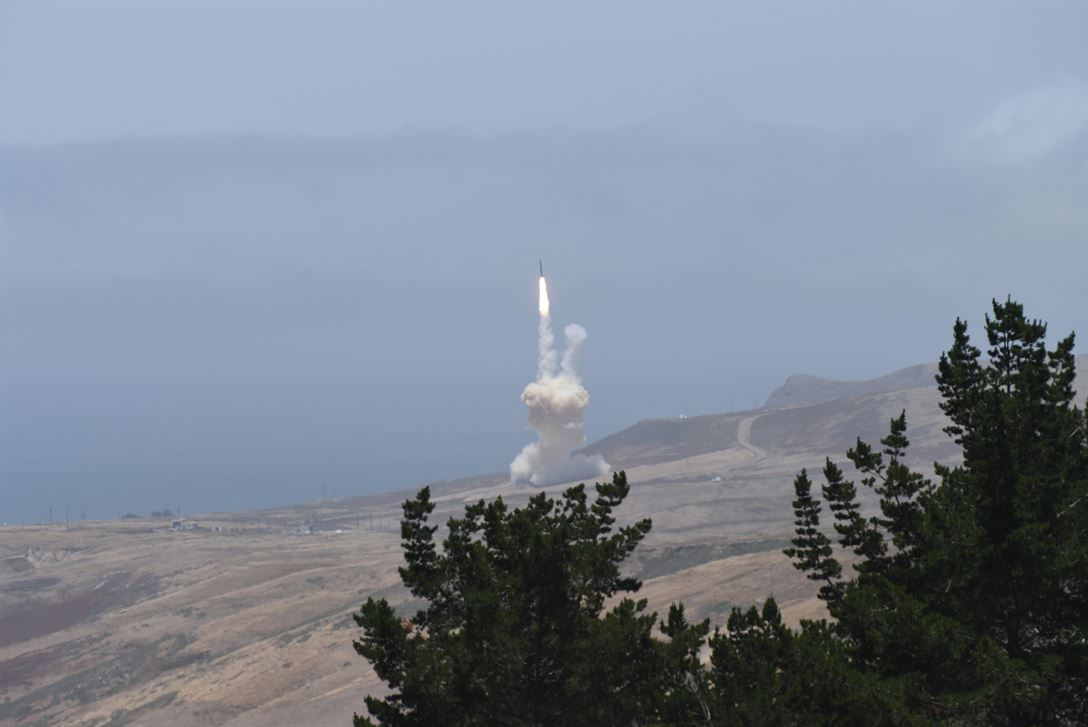A long-range ground-based interceptor launches from Vandenberg AFB, Calif., May 30, 2017, to intercept an intercontinental ballistic missile target that was launched from the US Army’s Reagan Test Site on Kwajalein Atoll in the Marshall Islands. This was the first live-fire test event against an ICBM-class target. The ground-based midcourse defense is an element of the Ballistic Missile Defense System. DOD photo by SrA. Robert J. Volio.
The current missile defense system protecting the United States will hold ahead of threats at least through 2020, Defense Department officials told members of the House Armed Services strategic forces panel on June 7.
Thomas Harvey, acting assistant secretary of defense for strategy, plans, and capabilities, and Missile Defense Agency Director Navy Vice Adm. James Syring said DOD is working both at home and abroad to provide proficient missile defense to the US and its allies, now and into the future.
The missile defense system that currently protects the United States, the Ground-based Midcourse Defense (GMD) system, was successfully tested in late May, intercepting an intercontinental ballistic missile target for the first time. The interception of a mock ICBM with a ground-based interceptor was “a complete end-to-end system test” that “validated the performance of our upgrades,” Norm Tew, Vice President and GMD Program Director at Boeing, told reporters on a conference call shortly after the test.
“Improving the capacity, reliability, and effectiveness of the GMD system is one of our highest priorities,” Harvey told the subcommittee, adding the Fiscal 2018 budget request would fund components of the GMD including a redesigned kill vehicle and long-range discrimination radar. Additionally, he said, the request would “help lay the groundwork for a new radar in Hawaii and would continue funding for advanced discrimination sensor technology and space-based kill assessment programs.”
The Missile Defense Agency requested $7.9 billion in its Fiscal 2018 budget request, including $1.5 billion for the GMD.
Regarding allied defense, Syring said the request “continues the deployment of missile defenses tailored to threats in Europe, Middle East, [and the] Asia Pacific region.”
In Europe, he said, “We will continue to implement the European Phased Adaptive Approach, EPAA, and [we are] working in close collaboration with our NATO allies to develop advanced network of sensors and interceptors.”
In the Middle East, “We’ve also maintained a robust ballistic missile defense presence,” Syring said, “including land- and sea-based assets deployed in defense of our forward-located forces and those of our allies and partners.”
In the Asia-Pacific, Syring noted, “Our force posture includes Aegis-capable ships along with Patriot batteries deployed in Japan and South Korea, and the recent deployment of THAAD [Terminal High Altitude Area Defense] to South Korea.”
“Today we’re ahead. We need to stay ahead,” Syring said. “Where we need to be prudent and constantly vigilant” is on “the capacity increase that we can expect from North Korea and … our capacity needed to meet that threat.”
On the same day and in a different hearing, nuclear posture officials once again defended the needs of the deterrence effort.
“Delaying modernization and warhead life extension efforts would degrade the effectiveness of these systems and would put at risk the fundamental objective of these systems: nuclear deterrence,” said James A. MacStravic, acting undersecretary of defense for acquisition, technology, and logistics. “… our choice is between modernizing those forces or watching a slow and unacceptable degradation in our ability to deter adversaries who represent existential threats to our nation.”
Asked whether extending the life of the aging Minuteman III is a more affordable option than pushing ahead with the Ground-Based Strategic Deterrent program, Air Force Global Strike Command boss Gen. Robin Rand said, “the short answer is no.”
“Our analysis is over the 50-year life span of GBSD, it’ll be $159 billion and the SLEP [service life extension program] of the current Minuteman III during that same period would be $160.3 billion,” said Rand. “It’s a $1.1 billion difference. So, just simply from financial, there’s no benefit there.”
Further, Rand argued, the current Minuteman doesn’t meet his three elements of deterrence: “to deter, the weapon that you use needs to be reliable; the weapons that you use need to be able to be survivable, and get to the target they’re intended for and destroy the target; and, three, there has to be will.”
“So, if we came up with 21st Century technology for a missile that we’re replacing and we are going to use 1970s and ’80s technology for command and control of that it will be very technically difficult to do and it’ll be very expensive to do,” he said. “This is a wonderful system that has now reached its retirement.”
